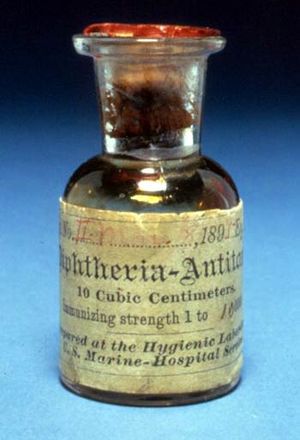مضاد التسمم

مضاد السم أو مضاد الذيفان أو الترياق (Antitoxin)، مادة تُصَنِّعها الخلايا الحية لمقاومة الأمراض التي تسببها السموم). وهذه السموم إفرازات لبعض الكائنات العضوية الدقيقة كالبكتيريا. ويستعمل الأطباء مضاد التسمم، لمعالجة أمراض مثل الكزاز والديفتيريا. ومضاد التسمم نوع من الأجسام المضادة له القدرة على معالجة الأمراض أو تخفيف حدتها أو توفير الوقاية منها.
ويُستخلص كثير من مضادات التسمم التجارية من حيوانات كالخيول والأرانب. فعندما يُحقن الحيوان بالمادة السامة، ينتج عن سريانها في مجرى دمه مادة مضادة للسم الذي حُقن به تجري مع مصل الدم. وثمَّة ذيفانات غير سامة معدلة كيميائيًا تُسمى الذوفانات تُحقن بها الأجسام أحيانًا لإفراز مضادات السموم. ويُستخلص المصل من دم الحيوان ثم يحقن به المريض. ومعظم مضادات السموم الحيوانية زهيدة الثمن وأسهل في الحصول عليها، بالمقارنة بما يستخلص من الإنسان، لكنها أقل فاعلية، وقد تَتسبَّب في حدوث آثار ضارة.
ولا تجعل مضادات السموم المحقونة المريض محصنًا حصانة دائمة من المرض. ومضادات التسمم التي يفرزها الجسم، عندما يتعرض الشخص للإصابة بذيفان معين تكون الأكثر فاعلية. وتفرز أنسجة الجسم مضادات السموم هذه مرة أخرى إذا هاجمت السموم الجسم مستقبلاً. وتتوافر الحماية من الإصابة عندما يكون تركيز المادة المضادة للتسمم مناسباً. كما أن مضادات التسمم التي تفرز بوساطة شخص آخر تكون فعّالة في معادلة المادة السامة، ولكنها لا تُعطي حماية دائمة. ويمكن تنشيط الحماية الدائمة في الجسم عند حقنه بالسموم المعطلة. [1]
التاريخ
Antitoxins to diphtheria and tetanus toxins were produced by Emil Adolf von Behring and his colleagues from 1890 onwards. The use of diphtheria antitoxin for the treatment of diphtheria was regarded by The Lancet as the "most important advance of the [19th] Century in the medical treatment of acute infectious disease".[2][3]
In 1888, Behring was sent to Berlin for a brief service at the Academy for Military Medicine. In 1889, he joined the Institute for Hygiene of the University of Berlin, then headed by Robert Koch. Between 1889 and 1895, Behring developed his pioneering ideas on serum therapy and his theory of antitoxins.[4]
Early 1887, in Bonn, Behring had found that the serum of tetanus-immune white rats contained a substance that neutralized anthrax bacilli. He recognized this as the source of their "resistance".[4] On 4 December 1890, Behring and Kitasato Shibasaburō published their first paper on blood-serum therapy.[4] On 11 December, another report, signed by Behring, discussed blood-serum therapy not only in the treatment of tetanus, but also in diphtheria.[بحاجة لمصدر]
When Paul Ehrlich demonstrated in 1891 that even vegetable poisons led to the formation of antitoxins in an organism, Behring's theory was confirmed.[4]
An antitoxin for scarlet fever was developed in 1924, simultaneously by Raymond Dochez and Gladys and George Frederick Dick.[5][6]
انظر أيضاً
مرئيات
| كيفية تحضير مضاد ذيفان الأفاعي. |
وصلات خارجية
- ^ الموسوعة المعرفية الشاملة
- ^ "Report of the Lancet special commission on the relative strengths of diphtheria antitoxic antiserums". Lancet. 148 (3803): 182–95. 1896. doi:10.1016/s0140-6736(01)72399-9. PMC 5050965.
- ^ Dolman, C.E. (1973). "Landmarks and pioneers in the control of diphtheria". Canadian Journal of Public Health. 64 (4): 317–336. PMID 4581249.
- ^ أ ب ت ث "Emil von Behring Facts, information, pictures". www.encyclopedia.com. Retrieved 17 مايو 2016.
- ^ Cushing, H.B. (August 1926). "Results of the use of scarlet fever antitoxin". Canadian Medical Association Journal. 16 (8): 936–939. PMC 1709338. PMID 20315893.
- ^ Zingher, Abraham (November 1924). "The Dick test and active immunization with scarlet fever Streptococcus toxin". American Journal of Public Health. 14 (11): 955–962. doi:10.2105/AJPH.14.11.955. PMC 1355058. PMID 18011363.
